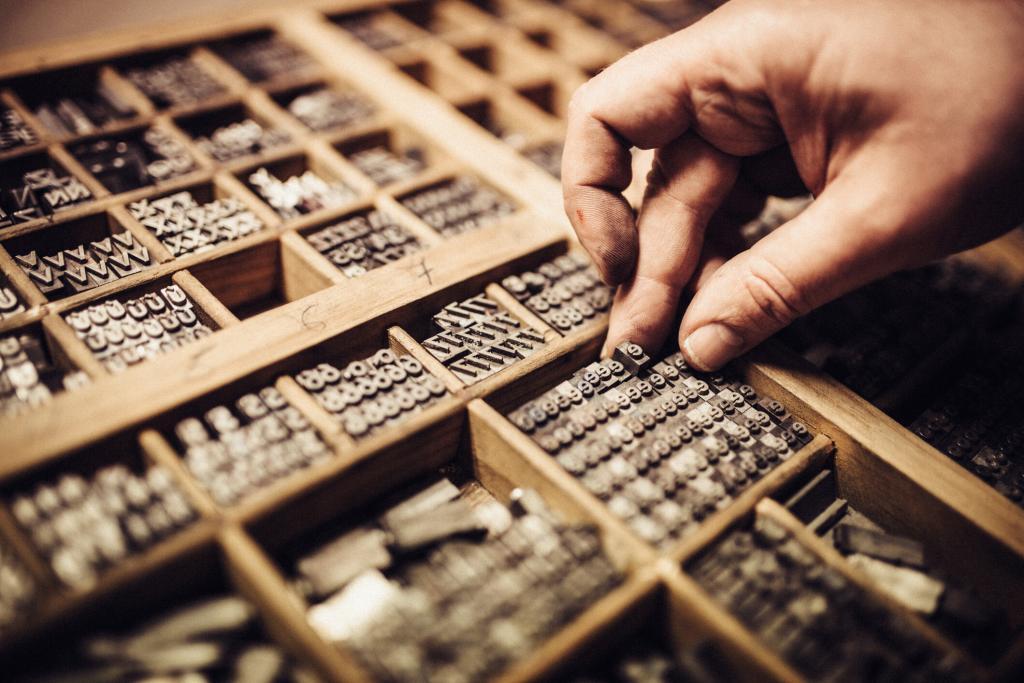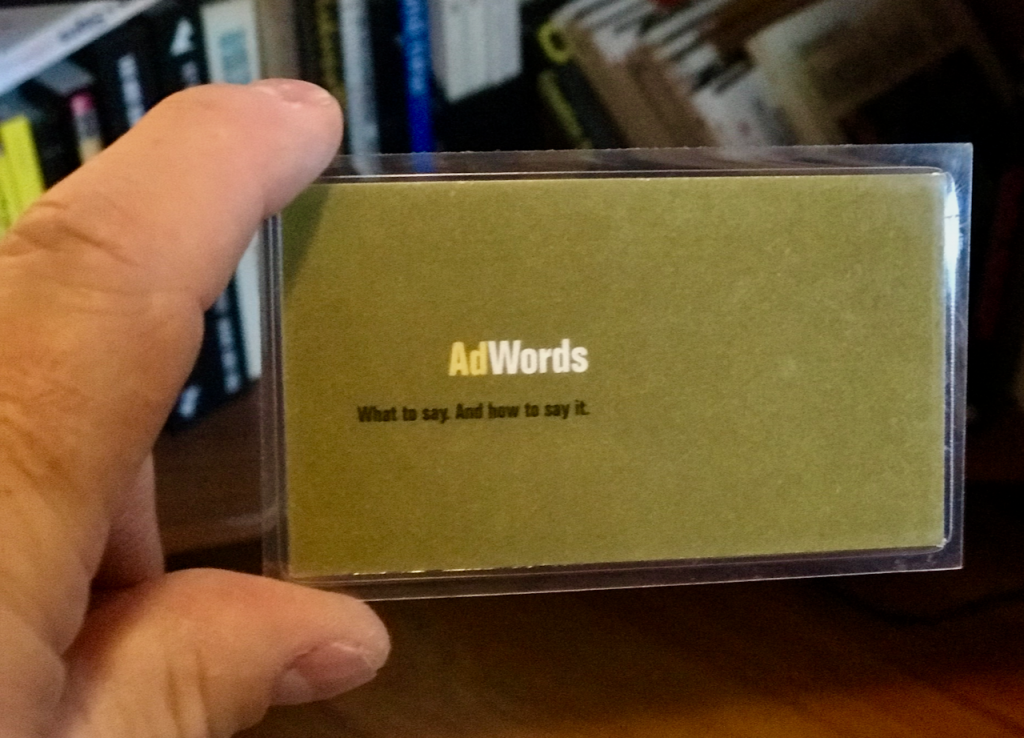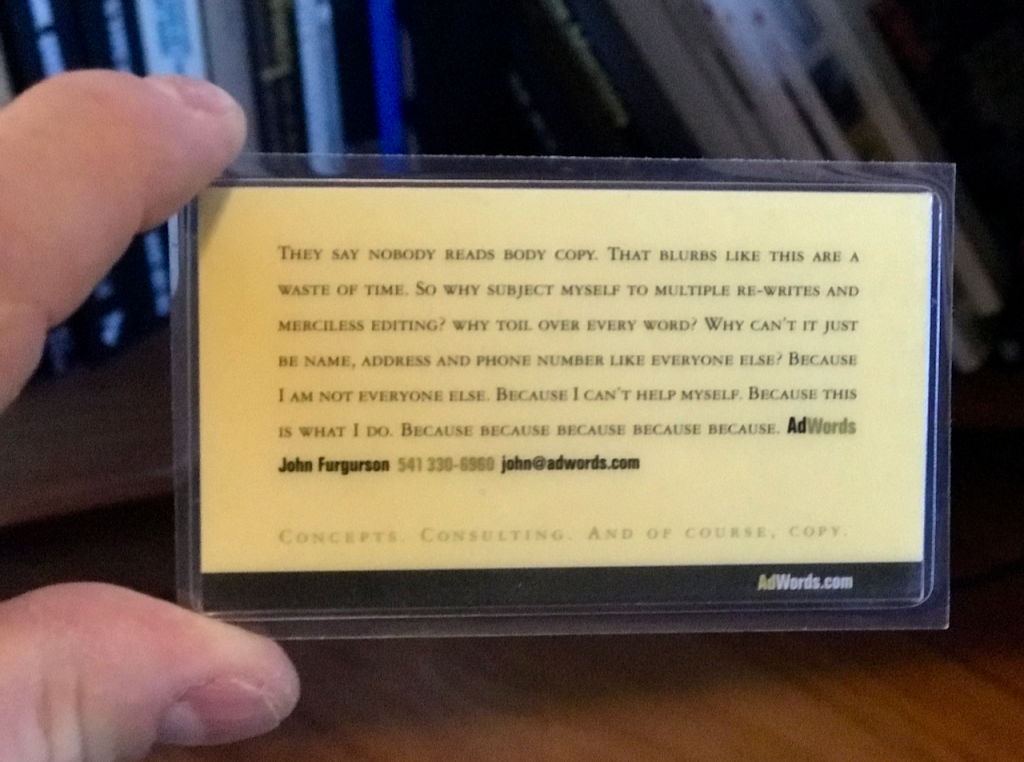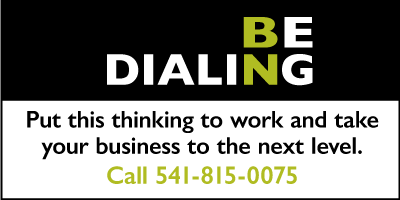![]()
Origin stories are big business in Hollywood. Millions of people pay top dollar at the box office to get the back-story on their favorite superhero or sci-fi villain. (The Joker grossed $849 million in just two months.) Unfortunately, brand origin stories are highly underrated and underutilized in the business world.
Let’s say you’re involved in a start-up and you’re pitching your idea to potential investors. They’re going to want to know where you came from. How you got there. And what you’re all about. A well-crafted brand origin story can answer those questions — in dramatic fashion.
A look back helps illuminate the way forward.
Sometimes it’s the founder’s entrepreneurial journey that attracts a tribe of like-minded people and helps get the company off the ground. In other cases it’s the team that triggers success… their past experiences, skill sets, passions or unique insights.
Sometimes it’s the product itself or the timing of the product launch that gives the company traction. Whatever the case may be, that brand origin story should be an important component of your brand narrative.
At BN Branding our clients never come asking for an origin story, but they almost aways need help with one.
When they come to us for a brand name and identity, we always start with the brand origin story.
When we dive into the heritage of a company, the reputation of the brand, and the past experience of the key players we often find the DNA of the brand hidden beneath the haze of time, growth and outside influences.
A lot of clients are just stuck. They have lost something they had when they first started their business, but they can’t put their finger on it.
That’s why it helps to go back to the very beginning.
Jim Stengel, formerly the Global Marketing Officer at Proctor & Gamble, gives many examples of companies that lost their way and had to look back to their heritage to find a way forward. Discovery Channel, Max Factor, Pampers, Harley Davidson all had to look back to their origin stories in order to succeed.
“I’ve seen again and again, that the heritage of a business holds vital clues to the potential for success in the present and in the future,” Stengel said.
“No organization can move forward if people don’t know what it stands for. And quite often, those core ideals get lost as the company grows.”
That’s one reason why origin stories are an important part of any company’s communication strategy.
Let me give you an example, and answer a question I get all the time about the naming of my own company…
This is the brand origin story of BN Branding…
It begins with my childhood crush on a couple of iconic brands. By the age of seven I was smitten was Tonka trucks and Schwinn bikes. I really, really, really wanted a Schwinn Sting Ray with the banana seat, sissy bar and a five-speed stick shifter.
 That never happened, and I’m scarred for life from the years I spent riding a cheaper, embarrassing knock-off that my dad bought at a thrift store.
That never happened, and I’m scarred for life from the years I spent riding a cheaper, embarrassing knock-off that my dad bought at a thrift store.
I’ll never forget the Christmas, some years later, when I finally got a yellow, Schwinn Varsity 10-speed. I had truly grown up… Way beyond the JV sting ray.
The other brand I was passionate about during those wonder years was Head skis. I got a hand-me-down pair from a racer friend of mine, and I was in snow-bound heaven. Head skis are the Schwinn of my winters, to this day.
Fast forward to high school when my infatuation with brands really blossomed. Classroom doodles were detailed recreations of skateboard brands and ski industry logos. I could draw perfect replicas of the iconic Rossignol R as well as the Sims logo, G & S, Nordica, Marker and Sun Valley.
My Peechee was a well-branded work of art and those logos are forever etched in my subconscious.
In graphic arts class I channeled that interest quite successfully. I created logos for imaginary companies, silk screened T shirts, ran a letterpress, worked in the dark room developing my own photos and learned to operate an offset press.
I can honestly say I quickly learned a trade. In fact, at the age of 15 I printed up a resume, walked into a local print shop and landed my first job, which I desperately needed to pay for my brand-name skateboards, brand-name ski gear and brand-name car.
 That print shop was not exactly what you’d call state-of-the-art. Quite the opposite, in fact. It was an ancient, run-down relic of a by-gone time. It reeked of ink, acetone and darkroom chemicals.
That print shop was not exactly what you’d call state-of-the-art. Quite the opposite, in fact. It was an ancient, run-down relic of a by-gone time. It reeked of ink, acetone and darkroom chemicals.
But I loved it.
The big, hand-fed letterpresses were similar to what we had at school, but the type collection was dramatically larger… Row after row of font drawers, each one full of backward letters and punctuation marks just waiting to be magically transformed into wedding invitations, event flyers or business cards.
That’s where I developed a keen awareness of letterforms, x heights, leading and line spacing. I learned to set type, literally… Choose a font. Fish out every letter. Set the spacing. “Lock it all up.” Hold the whole thing up to the mirror to check for typos.
Back to the drawer to replace that mistaken b with a d.
I developed an eye for how words look in type and I came to recognize inspired design work, true craftsmanship and high-quality printing.
I learned the hard way that graphic designers can be extremely meticulous, and that I’m a better writer than I am an artist.
But most of all, I learned at a very young age that image really matters. It’s was on-the-job training that serves me well to this day.
I had ink under my nails all through high school and college. My biggest take-aways from that experience in printing?…
1. The Linotype machine is one of the most amazing contraptions ever invented. (YouTube doesn’t do it justice.)
2. All the glamour’s on the front-end — in the planning, writing and design of those promotional materials. Not on the back end in production.
So in college I took all the advertising, writing and marketing classes I could. Then I took my Journalism degree and dove into a career in advertising.
I started as a direct response copywriter selling high-end goods for a company called Norm Thompson. In that environment money talks. Not art.
We tested everything, and routinely produced 25% response rates on direct sales letters to our house list. I learned that the right words translate directly into better response and more cash flow. It was the perfect training ground for a young copywriter.
I gave up the security of that position to pursue my dream of working in a “real” ad agency.
I worked in several Portland agencies where I did print campaigns, radio commercials and lots of collateral projects. (printed sales materials.) That’s where I learned the magic of the writer/art director collaboration, the toxicity of dysfunctional bosses and the pitfalls of the advertising agency business model.
That’s also where I learned to write award-winning radio ads. (I discovered I had a knack for writing dialog that sounds natural.)
But that agency experience left a gap in my on-the-job training. I wasn’t getting any opportunities to do TV. I didn’t feel well rounded, so I decided to take a career detour into corporate video work and direct response TV.
That’s where I learned how to write a video treatment and pitch a story idea. That’s where I learned how directors work and how valuable high production values really are.
After a few years of that my career path meandered in a different direction, to the small resort town of Bend, Oregon. It was a lifestyle choice that revolved around raising a family, so I hung up a shingle with just two clients.
What to call my fledgling little agency?
By that time I had done a half dozen naming projects, so I dove into the exercise with a fair bit of bravado, a blank pad of paper and the world’s thickest thesaurus.
I wanted something that would convey my USP at the time, which was an unusual combination of creative wordsmithing and insightful strategic planning. The work had to be creative, but also undeniably effective. So this name and tagline came pretty easily:

AdWords. What to say, and how to say it.
Short. Direct. Precise. Intriguing. Plus, the URL, www.adwords.com was available, so I snatched that up right away. (That was before URLs were the be-all end-all of corporate naming.)
The tagline, “what to say and how to say it” still rings true today. At BN Branding it’s strategy first, THEN execution.
Strategy determines what to say. Creative execution is the “how to say it” part. One without the other is like a Ferarri without a throttle.
So “AdWords” it was!
Over the next seven years I built a team and a substantial body of award-winning advertising work in tourism, technology, golf and real estate development.
Then, on February 10 of 2004, I got a phone call from an attorney who made an offer to purchase the AdWords brand name and URL. I thought it was a birthday prank from one of my buddies, and I politely declined.
But a couple months later he called back with a better offer. Then another, and another. He wouldn’t tell me who his client was, but it didn’t take a big leap of imagination to figure out it was Google. I held out for more than a year.
The windfall from that sale gave me time to write a book, start a non-profit children’s museum, reevaluate the direction of the firm, and rebrand my company.

Back to the drawing board.
As it turned out, the RE-branding process was much more difficult than my original branding effort.
As all Creatives know, doing work for yourself is harder than doing work for clients.
The cobbler’s shoe syndrome is rampant in my business.
First of all, I had to do some serious soul searching. I had to step back and take a realistic look at what the company was. And what is was NOT.
We never offered media buying as a service. That was not in our wheelhouse. So really, AdWords never was an ad agency. We provided creative services, and produced advertising in all forms, but it was more of creative boutique than an agency.
It was a bitter pill to swallow for someone who had dreamed of having an “agency.” And during that re-naming process I wasted a lot of time comparing my company to advertising agencies.
In that world there are a lot of acronyms… BBDO, CP+B, R/GA, WPP, and even TBD. But I hate acronyms. I’ve never recommended an acronym while doing a naming project. Not once. I have recommended the use of the owner’s name, but never an acronym.
I’ve never seen a cool, start-up ad agency use an acronym. They all gravitate toward hip, one word names like Smoke, Dig, Preacher, Cosmic, Omelet, Stoke or Walrus.
Seriously. I can’t make this stuff up.
The consensus on my team was, “No, nothing like that! That’d be off brand for us.” So the thousand dollar question was, what would be ON brand for me and my team?
The reality was this: It wasn’t just about me and my copywriting skills. It wasn’t even about advertising anymore. I had to let that go.
Clients were asking for much more, and our service bundle had evolved to accommodate those requests.
We were still delivering creative advertising work, but we were also working further up stream — doing brand strategy, marketing planning, small business consulting and account planning. It was a broad range of services that all fell under the broad umbrella of branding.
So it was decided… we would be a branding firm. Or a strategic brand consultancy. Or a branding agency. Something like that. But we still needed a name.
We kicked around a whole slew of options, including one that was just a symbolic letter. V. Not V Branding, just V. That one was interesting, but a bit of a stretch.
We toyed with “Guidon” which was also interesting, but its military connotations caused problems. 
Another practical consideration was corporate structure. I was advised to incorporate, but I already had one S corp in the family, so it seemed like a lot of unnecessary legal mumbo jumbo to me. Two corporate tax returns… really? Why not just become part of the family business?
My wife had a market research firm called BN Research, and there was some synergy between the two companies.
BN Branding. Hmmmmm… Seemed kind of boring, but it had a nice ring to it. Good phonetics.
So I put that idea in the drawer and continued down the rabbit hole that is namestorming. It’s never easy… sometimes it takes weeks to come up for air.
In the end, those two letters kept rising back to the surface… BN, BN, BN.
So we started playing around with this question: What else could the B and the N stand for? How could we attach meaning to those two letters and extend it into a campaign that has legs… something that would be graphically bold and completely different than anything else in the Branding niche.
Gary Vanyerchuck , aka “Gary Vee,” has built a brand around his hard to pronounce name. When asked about that, he said, “a brand name is not chosen, it’s made. You have to make something out of it.”
That’s exactly what we’ve done with the “Be” campaign. We started with a rather benign name, and built something memorable around it.
It started with two simple words: Be Iconic. That was the spark of the idea… They I said, what’s more iconic than the curves of Coca-Cola bottle?
![]()
Then came Be Inspired, which implies a broader role where we’re touching more than just design and advertising. We inspire entire teams, not just marketing guys.
Suddenly the name BN Branding didn’t seem like a bad idea at all.
17 years later we’re still working out new ideas for the “Be” campaign. Those two green letters are now iconic, in their own right. You don’t even need to see the name or the logo to know it’s a message from BN Branding.
BN by itself is not an exciting name, but Be Iconic is the main benefit of working with us. Be Inspired is what clients are looking for. Be Nice is how we roll.
We’ve attached meaning to those two letters over time, and the more we repeat those, the stronger our brand becomes. BN is just a trigger for a much bigger, more meaningful idea.
Our clients can fill in the blanks. They can “be” whatever they want to be.
So that’s our brand origin story, and the answer to the common question “why do you call it BN Branding?”
So, what can the average business owner learn from the branding of a branding company?
• Naming is probably the hardest step in the brand identity development process. It’s even hard for professionals who have 25 years experience. Don’t assume that you can do it yourself.
• Details, visual aids, and quality writing makes a big difference in the value of your brand origin story. Like any good story, it needs characters and conflict. It needs to ebb and flow… you can’t just go straight to success.
• Look to the past for inspiration and a compelling brand origin story, but don’t hang on too tightly to what you thought you were. You gotta Be Nimble. Circumstances change, people leave, markets shift, but brands endure.
• When evaluating possible names it’s often helpful to step back and look at the bigger picture. Get away from the word and the URL hunt, for a bit, and think big. It has to start with a big idea.
• Your company name is only one component of your brand identity. It’s important, for sure, but it seldom stands alone. It’s always “consumed” within the context of something else. You have to support the brand name, and make something of it.
• Names that may not seem all that great at first can become quite powerful as context and meaning is revealed over time.
• Context matters. A well-crafted brand origin story provides context for people, and can create greater understanding of your real value.
• Brand origin stories are especially important for service business and companies that revolve around a few, key people.
• A good origin story can become the stuff of urban legend, told and retold to your benefit.
If you’d like some help exposing your brand DNA and telling your origin story, give us a call. We’d love to hear it.
![]()

BN Branding explains the importance of a brand’s origin story in naming and rebranding, suggesting it helps define the brand’s mission and values. A strong origin story can create a deeper connection with consumers, offering clarity and authenticity as part of the brand’s identity and strategy.